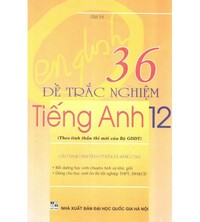Unit 3 - Grammar Bank - SBT Tiếng Anh 12 Bright
1. Choose the correct option. 2. Combine the sentences using who(m), that whose, where, when or why. 3. Choose the correct option. 4. Choose the option (A, B, C or D) to indicate the underlined part that needs correction.
Bài 1
1. Choose the correct option.
1. September is the month _____ I start my journalism course.
A. which B. where C. why D. when
2. The interesting topics were the reason _____ her podcasts became so popular.
A. whose B. why C. which D. when
3. Dave is the person _____ told me how to spot false news.
A. that B. whom C. where D. which
4. We watched a documentary _____ was very interesting.
A. who B. whom C. which D. whose
5. MoneySaving4All is the podcast channel _____ Greg Leiter gives great advice on money management.
A. where B. why C. when D. who
6. Graham is the man _____ son is a popular podcaster.
A. which B. whose C. who D. that
Lời giải chi tiết:

1. September is the month when I start my journalism course.
(Tháng 9 là tháng tôi bắt đầu khóa học báo chí.)
Giải thích: ta có the month là danh từ chỉ thời gian nên ta điền when vào chỗ trống.
2. The interesting topics were the reason why her podcasts became so popular.
(Những chủ đề thú vị là lý do khiến podcast của cô ấy trở nên phổ biến.)
Giải thích: ta có dấu hiệu the reason chỉ lí do ta điền why vào chỗ trống.
3. Dave is the person that told me how to spot false news.
(Dave là người đã chỉ cho tôi cách phát hiện tin giả.)
Giải thích: ta có the person là danh từ chỉ người ta điền who hoặc that vào chỗ trống.
4. We watched a documentary which was very interesting.
(Chúng tôi đã xem một bộ phim tài liệu rất thú vị.)
Giải thích: ta có documentary là một danh từ chỉ vật ta điền which vào chỗ trống
5. MoneySaving4All is the podcast channel where Greg Leiter gives great advice on money management.
(MoneySaving4All là kênh podcast nơi Greg Leiter đưa ra những lời khuyên hữu ích về quản lý tiền bạc.)
Giải thích: ta có podcast channel (kênh podcast) là một địa điểm nên ta điền where vào chỗ trống.
6. Graham is the man whose son is a popular podcaster.
(Graham là người đàn ông có con trai là một người dẫn podcast nổi tiếng.)
Giải thích: Ta có the man là danh từ chỉ người và đằng sau chỗ trống có một danh từ son đi kèm, ta dùng đại từ quan hệ whose.
Bài 2
2. Combine the sentences using who(m), that whose, where, when or why.
(Kết hợp các câu sau dùng who(m), that, whose, where, when hoặc why.)
1. Is that woman your aunt? Her podcasts are mainly about health and well-being.
2. It was August. We started creating podcasts about marathon running.
3. She knew very little about the journalist. She agreed to give him an interview.
4. That is a building. The town's first newspaper was published there.
5. He left the radio station. The reason was that he wanted to get a job in TV.
Lời giải chi tiết:
1. Is that woman whose podcasts are mainly about health and well-being your aunt?
(Người phụ nữ có podcast chủ yếu nói về sức khỏe và hạnh phúc có phải là dì của bạn không?)
2. It was August when we started creating podcasts about marathon running.
(Đó là tháng 8 khi chúng tôi bắt đầu tạo podcast về chạy marathon.)
3. She knew very little about the journalist who/that she agreed to give an interview.
(Cô ấy biết rất ít về nhà báo mà cô ấy đã đồng ý trả lời phỏng vấn.)
4. That is the building where the town's first newspaper was published.
(Đó là tòa nhà nơi xuất bản tờ báo đầu tiên của thị trấn.)
5. He wanted to get a job in TV was the reason why he left the radio station.
(Anh ấy muốn kiếm được một công việc trong lĩnh vực truyền hình là lý do khiến anh ấy rời đài phát thanh.)
Bài 3
Double comparatives (So sánh kép)
3. Choose the correct option. (Chọn đáp án đúng.)
1. The less news I read, _____ I have to worry about.
A. the least B. the less C. less D. the less than
2. The more time you spend online, the _____ your eyes will get.
A. much more tired B. tired and tired C. more tired D. less tired
3. The _____ the headline is, the more people want to read it.
A. more crazy B. most crazy C. crazier D. craziest
4. The more time he spends reading the news, the _____ he becomes.
A. unhappier B. unhappy C. more unhappy D. unhappiest
5. The more adverts a channel has, the _____ people want to watch it.
A. less B. least C. fewest D. fewer
Lời giải chi tiết:
|
1. B |
2. C |
3. C |
4. A |
5. D |
1. The less news I read, the less I have to worry about.
(Càng đọc ít tin tức, tôi càng ít phải lo lắng.)
Giải thích: The more/less + danh từ + S1 + V1, the more/less + danh từ + S2 + V2
Ta dùng less cho danh từ không đếm được còn fewer dùng cho danh từ đếm được.
2. The more time you spend online, the more tired your eyes will get.
(Càng dành nhiều thời gian lên mạng, mắt bạn sẽ càng mỏi.)
Giải thích: The more/less + danh từ + S1 + V1, the more/less + tính từ/trạng từ+ S2 + V2
Ta dùng less cho danh từ không đếm được còn fewer dùng cho danh từ đếm được.
3. The crazier the headline is, the more people want to read it.
(Tiêu đề càng điên rồ thì càng có nhiều người muốn đọc nó.)
Giải thích: The more/less + tính từ/trạng từ + S1 + V1, the more/less + danh từ + S2 + V2
Ta dùng less cho danh từ không đếm được còn fewer dùng cho danh từ đếm được.
4. The more time he spends reading the news, the unhappier he becomes.
(Càng dành nhiều thời gian để đọc tin tức, anh ta càng trở nên bất hạnh.)
Giải thích: Giải thích: The more/less + danh từ + S1 + V1, the more/less + tính từ/trạng từ+ S2 + V2
Ta dùng less cho danh từ không đếm được còn fewer dùng cho danh từ đếm được.
5. The more adverts a channel has, the fewer people want to watch it.
(Kênh càng có nhiều quảng cáo thì càng ít người muốn xem kênh đó.)
Giải thích: The more/less + danh từ + S1 + V1, the more/less + danh từ + S2 + V2
Ta dùng less cho danh từ không đếm được còn fewer dùng cho danh từ đếm được.
Bài 4
4. Choose the option (A, B, C or D) to indicate the underlined part that needs correction.
(Chọn đáp án (A, B, C hoặc D) để chỉ ra phần gạch chân cần sửa lại.)
1. Advertisements on TV are getting long (A) and longer (B) as well as more (C) and more (D) often.
2. Few (A) and fewer (B) people are watching the TV news these days as more and more (C) people are getting the (D) news online.
3. Advertisements are (A) becoming more (B) and more attractively (C) to catch (D) more people's attention these days.
4. People's attention spans are getting shorter and shorter (A) as they become less (B) addicted to (C) their screens and scroll faster and faster (D).
5. More (A) and more (B) teens are becoming social influencers because they (C) think they can make more money doing that as (D) anything else.
Lời giải chi tiết:
1. Advertisements on TV are getting longer and longer as well as more and more often.
(Quảng cáo trên TV ngày càng dài hơn và ngày càng thường xuyên hơn.)
Giải thích: tính từ ngắn-er + and + tính từ ngắn-er, ta sửa long (A) thành longer.
2. Fewer and fewer people are watching the TV news these days as more and more people are getting the news online.
(Ngày nay ngày càng ít người xem tin tức trên TV vì ngày càng có nhiều người xem tin tức trực tuyến.)
Giải thích: tính từ ngắn-er + and + tính từ ngắn-er, ta sửa few (A) thành fewer.
3. Advertisements are becoming more and more attractive to catch more people's attention these days.
(Quảng cáo ngày càng trở nên hấp dẫn để thu hút sự chú ý của nhiều người hơn.)
Giải thích: become + adj: trở nên như thế nào, ở đây ta sửa attractively thành attractive
4. People's attention spans are getting shorter and shorter as they become more addicted to their screens and scroll faster and faster.
(Khoảng chú ý của mọi người ngày càng ngắn hơn khi họ ngày càng nghiện màn hình và cuộn ngày càng nhanh hơn.)
Giải thích: theo nghĩa của câu, ta sửa less (C) thành more.
5. More and more teens are becoming social influencers because they think they can make more money doing that than anything else.
(Ngày càng có nhiều thanh thiếu niên trở thành những người có ảnh hưởng xã hội vì họ nghĩ rằng họ có thể kiếm được nhiều tiền hơn khi làm việc đó hơn bất cứ điều gì khác.)
Giải thích: Xét theo nghĩa của câu, ta sửa as (D) thành than.
Search google: "từ khóa + timdapan.com" Ví dụ: "Unit 3 - Grammar Bank - SBT Tiếng Anh 12 Bright timdapan.com"







